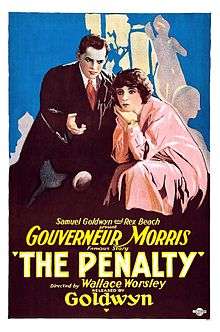The Penalty (1920 film)
| The Penalty | |
|---|---|
 Original release poster. The Penalty was originally a sole Goldwyn production in 1920 and was rereleased by MGM in the late 1920s. | |
| Directed by | Wallace Worsley |
| Produced by |
Samuel Goldwyn Rex Beach |
| Written by |
Charles Kenyon Philip Lonergan |
| Based on |
The Penalty by Gouverneur Morris |
| Starring | Lon Chaney, Sr. |
| Cinematography | Donovan Short |
| Edited by | Frank E. Hull |
| Distributed by | Goldwyn Pictures |
Release date |
|
Running time | 90 minutes |
| Country | United States |
| Language | Silent (English intertitles) |
The Penalty is an American crime film starring Lon Chaney and originally released in 1920. The movie was directed by Wallace Worsley, and written by Philip Lonergan and Charles Kenyon, based upon the pulp novel by Gouverneur Morris. The supporting cast includes Charles Clary, Doris Pawn, Jim Mason, and Claire Adams.[1]
Plot
As described in a film magazine,[2] Blizzard (Chaney), a legless cripple whose cunning and criminal mind make him the master of the Barbary Coast underworld, is possessed of two ambitions. One is to get revenge upon Dr. Ferris (Clary), whose blunder during a childhood operation resulted in his legs being mistakenly amputated; the other is to rally the Reds in his organization and loot the city of San Francisco. To accomplish one Blizzard poses for the bust of Satan which is expected to be the masterpiece of Barbara Ferris (Adams), daughter of the doctor, gaining her sympathy and eventually threatening to force her marriage to him. To effect the other, he organizes the dance hall girls to work at the making of hats in a factory room at this house, the hats to be the symbol of the lawbreaking hordes when they are unleashed on the city. Rose (Terry), a detective, obtains entrance to his house as director of the factory. She is brought to love Blizzard for his passion for music. The life of the fiance of Barbara is endangered by Blizzard, who has the idea that the man's legs should be grafted on Blizzard's stumps, a second operation clears Blizzard's brain and he sees with a clear vision his fearful, terrible past, which falls away as if a dream. When happiness comes in his marriage to Rose, his former confederate Frisco Pete (Mason), a drug fiend fearful that Blizzard will reveal the identity of his gang of followers, takes the leader's life. Barbara and her lover are restored to one another.
Cast
- Charles Clary as Dr. Ferris
- Doris Pawn as Barbary Nell
- James Mason as Frisco Pete
- Lon Chaney as Blizzard
- Milton Ross as Lichtenstein
- Ethel Grey Terry as Rose
- Kenneth Harlan as Dr. Wilmot Allen
- Claire Adams as Barbara Ferris
- unbilled
- Montgomery Carlyle as A Crook
- Cesare Gravina as Art Teacher
- Lee Phelps as Policeman
- Madlaine Traverse as Woman
- Edouard Trebaol as Bubbles
- Clarence Wilson as A Crook
Production


Chaney refused to use trick camera angles in this film. Instead, he wore an apparatus to simulate amputated legs, which consisted primarily of two wooden buckets and multiple leather straps, was complex and incredibly painful. Chaney's knees sat in the buckets, while his lower legs were tied back. Studio doctors asked that Chaney not wear the device, but he insisted on doing so, so that his costume would be authentic.
To assure audiences that Chaney was not an amputee, the original release of the film reportedly included a short epilogue clip showing Chaney out of character. This clip does not survive in the existing prints but in the movie itself, in the scene where Blizzard (Chaney) imagines his gang of anarchists carrying the loot from the Mint Building, Chaney is seen directing the heist unamputated.
Preservation
A print of The Penalty is in the George Eastman House Motion Picture Collection.[1]
Legacy
The Penalty was one of Chaney's breakout roles, showcasing his taste for the macabre and talent for contortion and disguise. He had previously demonstrated similar qualities in the previous year's The Miracle Man, but The Penalty and Treasure Island, both of 1920, secured Chaney's place as one of America's most famous character actors, before moving on to his more famous roles in 1923's The Hunchback of Notre Dame and 1925's The Phantom of the Opera.
In 2009 Empire Magazine named it #17 in a poll of the 20 Greatest Gangster Movies You've Never Seen* (*Probably).
References
- 1 2 Progressive Silent Film List: The Penalty at silentera.com
- ↑ "Reviews: The Penalty". Exhibitors Herald. New York City: Exhibitors Herald Company. 11 (14): 89. October 2, 1920.
- Skal, David J., The Monster Show, p. 65. ISBN 0-571-19996-8
External links
| Wikimedia Commons has media related to The Penalty (film). |
| Wikiquote has quotations related to: The Penalty (1920 film) |
- The Penalty at the American Film Institute Catalog
- The Penalty on IMDb
- The Penalty is available for free download at the Internet Archive
- The Penalty at AllMovie
- The Penalty at the TCM Movie Database
- The Penalty at Rotten Tomatoes